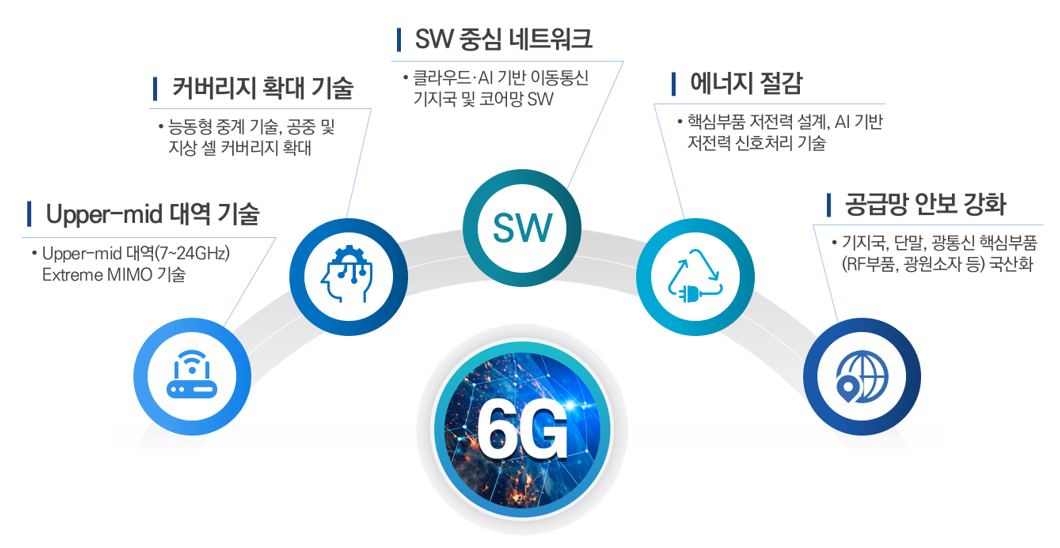과기부는 23일 서울중앙우체국에서 개최된 2023년 제10회 국가연구개발사업평가 총괄위원회에서 차세대 네트워크(6G) 산업 기술개발사업이 총 4,407.3억원(국비 3,731.7억원) 규모로 예비타당성 조사를 통과하였다고 밝혔다.
6G 산업 기술개발사업 예비타당성 조사 통과
2026년 Pre-6G 시연·특허 점유율 30% 목표
과기부가 총 4400억 규모의 6G 통신 산업 기술개발사업이 예비타당성 조사를 통과해 본격 경쟁력 확보에 나섰다.
과기부는 23일 서울중앙우체국에서 개최된 2023년 제10회 국가연구개발사업평가 총괄위원회에서 차세대 네트워크(6G) 산업 기술개발사업이 총 4,407.3억원(국비 3,731.7억원) 규모로 예비타당성 조사를 통과하였다고 밝혔다.
이에 따라 2021년부터 추진 중인 6G 원천기술 연구와 연계해 2024년부터 6G 상용화기술 및 핵심부품 개발을 본격화하고 이를 바탕으로 국제표준에 반영한다. 2026년 Pre-6G 기술 시연, 6G 국제표준특허 30% 확보 등 우리나라가 차세대 네트워크의 경쟁력 확보에 나선다.
전 세계적으로 6G 기술개발 투자 및 신규 6G 후보주파수대역 발굴 및 가속화·개방화로의 네트워크 패러다임이 전환되고 있다. 우리나라도 이에 대응하여 △Upper-mid 대역(7~24GHz) 기술 △커버리지 확대 기술 △소프트웨어(SW) 중심 네트워크 △에너지 절감 △공급망 안보 강화 등 5대 분야에 대해 기술개발을 추진한다.
5G 3.5GHz의 용량 한계와 28GHz의 커버리지 한계를 극복하는 어퍼 미드(Upper-mid) 대역(7~24GHz) 기술을 개발한다.
최근 미국 연방통신위원회(FCC)와 퀄컴, 에릭슨, 노키아 등 세계적인 통신장비 제조사가 6G 후보주파수 대역으로 해당 주파수 대역을 주목하고 있어 이 대역을 바탕으로 부품 개발이 추진된다.
특히 5G 핵심부품으로 꼽히는 ‘대용량 다출입 안테나 기술(massive MIMO)’ 대비 4배 이상 성능을 향상시킨 ‘초대용량 다출입 안테나 기술(E-MIMO : Extreme Massive MIMO)’과 이러한 안테나 부품을 제어하는 IC칩을 개발해 우리나라가 6G 글로벌 주도권을 확보하도록 기여할 계획이다.
또한 높은 주파수 활용에 따라 발생하는 커버리지 한계를 극복하기 위한 연구를 진행한다. 수동형 중계 기술을 토대로 한 현재의 기지국은 주변 고정된 범위의 지상 위주 통신만 가능하다. 6G에서는 능동형 중계 기술을 활용하여 보다 음영지역을 없애고, 넓은 범위까지 통신이 가능하게 할 계획이다. 해당 기술이 적용되면 상용화 초기 발생하는 커버리지에 대한 불편함을 방지할 수 있게 된다.
HW 중심에서 클라우드·SW로 전환되는 네트워크 변화에 대응하여 SW 중심 네트워크 기술을 개발된다. SW화가 일부 진행된 5G 모바일 코어 기능을 클라우드 기반 모바일 코어망 SW(Cloud-Native 기술)로 발전시켜 나가는 한편, 기지국 장비도 가상화·개방화·지능화를 가능하게 하는 SW기술을 클라우드를 활용해 개발한다.
전 세계적인 탄소중립 추세에 맞춰 6G 에너지 절감 기술 개발과 연계해 더 높은 성능을 지원하면서 에너지도 절감하는 기술도 개발한다. 6G는 5G 대비 전반적인 시스템이 복잡해짐에 따라 전력 소모가 증가될 것으로 예상되며, 이에 따라 저전력 설계 기술이 필요하다. 통신시스템에서 전력 사용의 대부분을 차지하는 기지국(약 73%)의 핵심부품의 저전력 설계 및 저전력 신호처리 기술 등을 개발하고, 코어망 네트워크 관리 기술도 고도화해 효율을 강화한다.
외산에 의존하고 있는 기지국, 단말, 광통신 등의 핵심부품을 국내 기술로 개발하여 통신장비·부품의 공급망을 강화한다. 수요기업인 대기업과 공급기업인 중견·중소기업 간의 협력을 통해 수요처의 요구수준-개발기술 간 격차를 줄인다. 이를 통해 개발 결과물의 상용화 경쟁력이 강화되고 국내 기술이 활용된 부품의 시장 출시 가능성이 높아질 전망이다.
연구 성과물이 6G 상용화 시기에 실질적으로 활용될 수 있도록 단계마다 기술을 검증한다. 2026년에는 주요국 통신사, 제조사, 표준 전문가, 정부 관계자 등을 초청해 'Pre-6G 기술 시연' 행사 개최를 목표한다. 2028년에는 국내 대기업과 중견·중소기업 협력을 통해 연구개발 성과물의 통합시스템 시연을 추진, 6G 생태계 비전과 가능성을 제시함과 동시에 초기 6G 시장에서의 경쟁력을 확보한다.
이를 통한 연구개발성과물을 국제표준에 반영하여 우리나라가 6G 국제표준특허 점유율 30% 이상을 확보하는 데에 기여할 계획이다. 이동통신이 전세계 단일표준시장인만큼 기술 확보부터 표준선점, 조기 상용화를 이뤄내 표준 선도를 위한 기반이 될 것으로 기대된다.
과기정통부 홍진배 네트워크정책실장은 “이번 예타 통과를 계기로 올해 2월 ‘K-Network 2030 전’에서 발표한 6G 연구개발 투자 확대, ’26년 Pre-6G 기술 시연 등을 차질없이 추진할 수 있는 기반이 마련되었다”라면서, “치열한 글로벌 네트워크 기술패권 경쟁을 민첩하게 대응하여 우리나라가 세계 최고 디지털 인프라 강국으로서 한발 더 앞서 나갈 수 있도록 노력하겠다”라고 밝혔다.

.png)